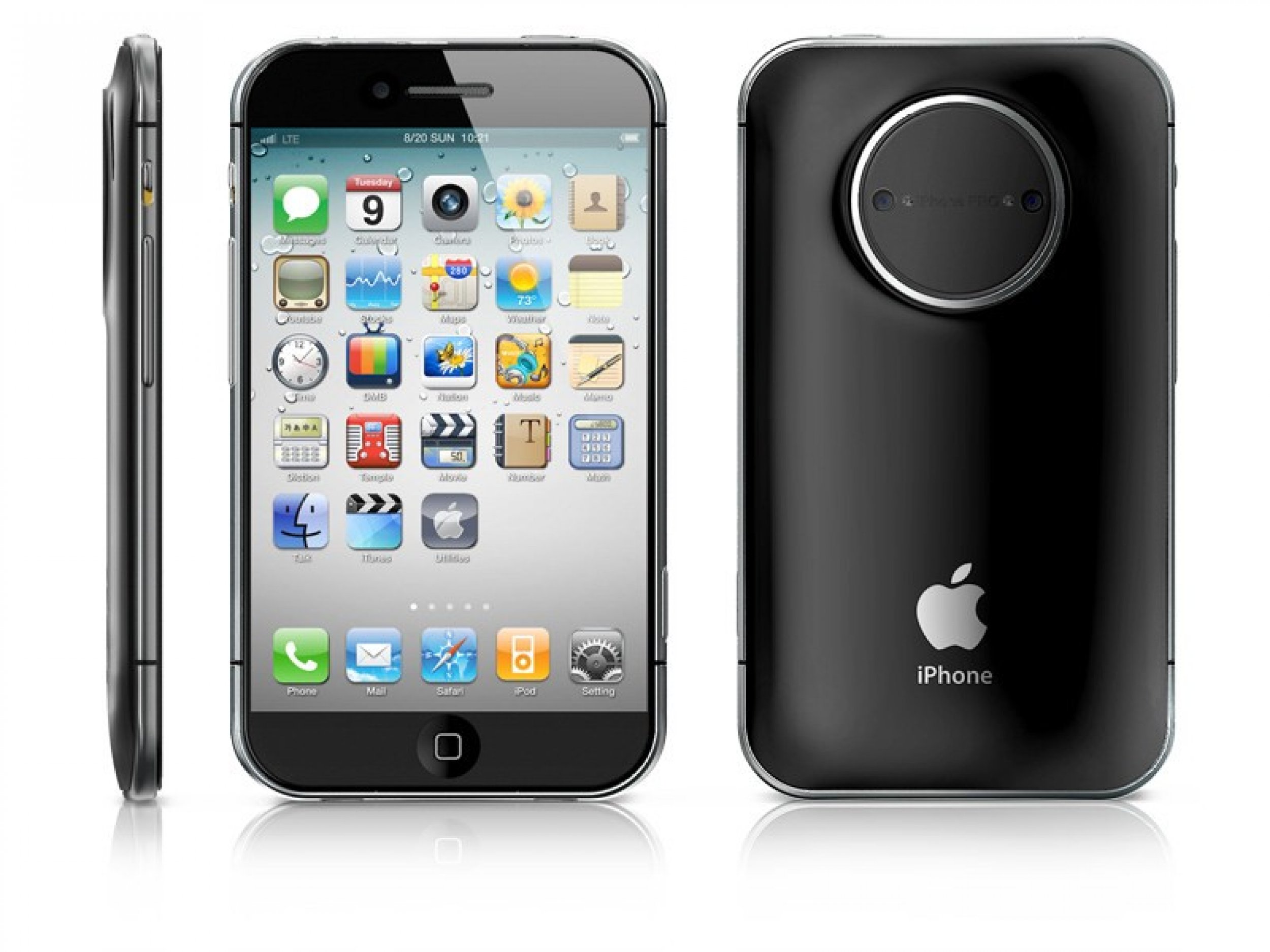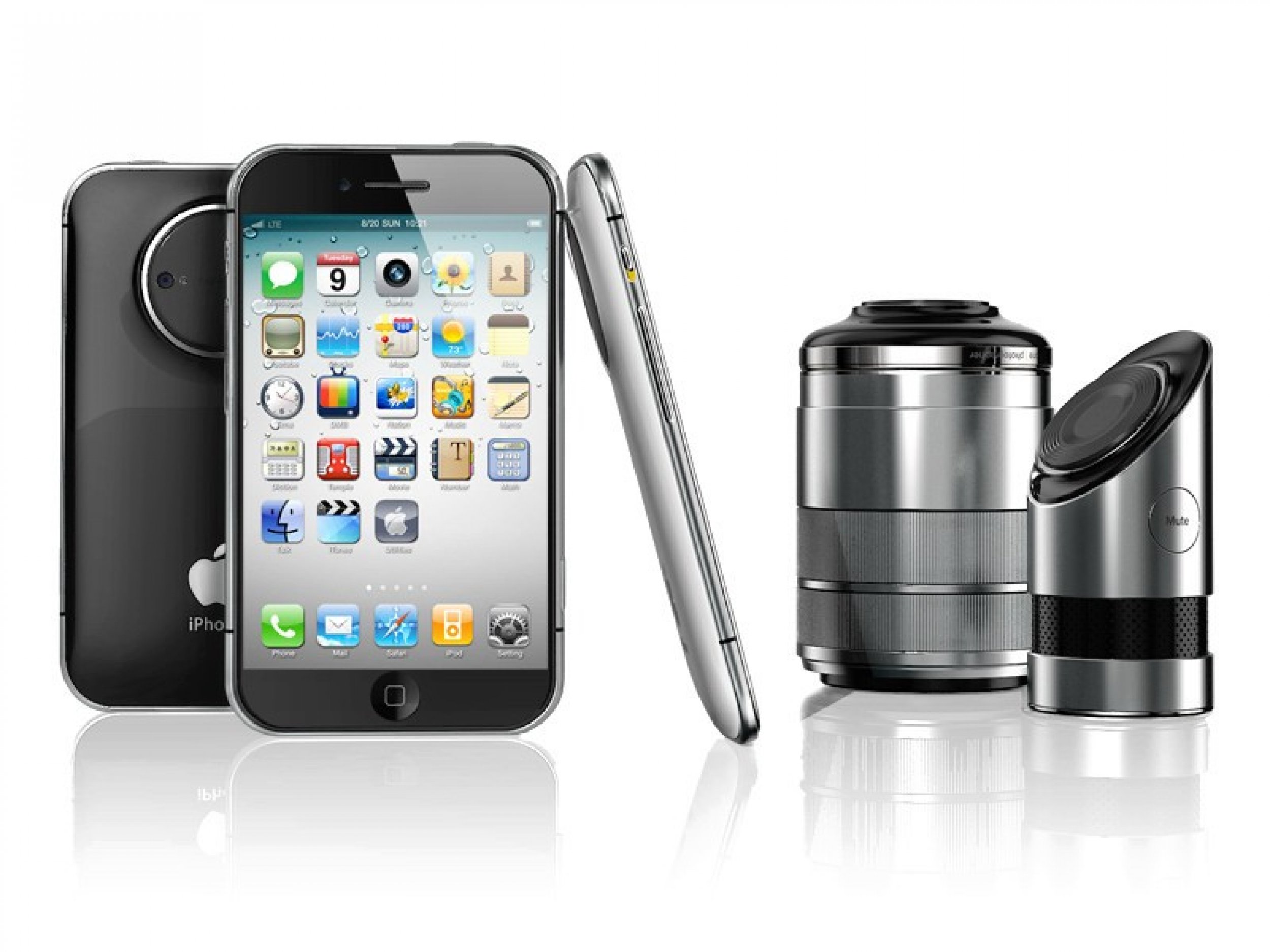Apple iPhone 5 'Pro' Concept: New Design Features 4.5-Inch Screen, Built-In Projector, DSLR Lens Mount [PICTURES]
Even though nobody outside of Cupertino, Calif., knows what the iPhone 5 looks like, what it can do, or when it's coming out, that hasn't stopped artists from fashioning their own concept designs of Apple's sixth-generation smartphone. The latest design comes from South Korean product designer Jinyoung Choi, who used details from the latest report of a 4.6-inch screen to create his own special iPhone concept, called iPhone PRO.
The iPhone PRO features a 4.5-inch wide LCD edge-to-edge screen, two side buttons, and a slightly curved form factor that mirrors the iPhone 3G and 3GS more so than the rectangular iPhone 4 and 4S. The iPhone PRO also comes with a removable hard disk and a portable speaker, but the smartphone's major features are centered around its camera systems.
The iPhone PRO also comes with a 1.2-megapixel camera that can shoot 3D pictures and video, as hinted by the company's recently granted patent for a 3D imaging camera, but the next-gen Apple smartphone also lives up to its Pro name thanks to a digital single-lens reflex (DSLR) lens mount on the back of the iPhone. An DSLR camera attachment would make the iPhone usable for professional-grade photography, thanks to larger image sensors, a higher dynamic range and a higher signal to noise ratio.
Choi's iPhone PRO concept also comes with another quirky accessory: A built-in projector system. By attaching the iPhone's DSLR mount to this slick accessory, the iPhone can project its high-resolution images onto any surface, which would make videos, documents, and photos easy to share with everyone in the room.
While this iPhone 5 concept design is beautiful, it is only a concept. Reports of Apple's sixth-generation iPhone describe a slightly different picture -- and no mention of a DSLR attachment.
On March 21, Apple had reportedly ordered 4.6-inch screens, to be featured in the company's next iPhone. The report came from a South Korean publication, the Maeli Business Newspaper, which quoted an unnamed industry source, according to Reuters.
Two days later, a new report from iMore's editor-in-chief Rene Ritchie stated the iPhone 5 retains the current 3.5-inch screen -- the same size as all previous generation iPhones -- but Apple added a few new features. Ritchie also said the phone would be released in October 2012.
Ritchie has a solid track record with Apple news. Last August, Ritchie correctly reported Apple's next iPhone would be unveiled in the first week of October and would be called iPhone 4S, while all other reporters at the time called the speculative device the iPhone 5. Ritchie also correctly pegged the new iPad's unveiling on March 7.
While Ritchie believes the iPhone 5 could get a little bigger than its predecessors, he said that it would not be nearly as big as those 4.5-inch-plus Android smartphones.
The truth seems to be somewhere in between Ritchie's report and the Korean source. In early January, as Apple was reportedly gearing up to begin production on the iPhone 5. A source from within China's Foxconn manufacturing plant told 9 to 5 Mac that various sample iPhone 5 prototypes were floating around the factory floor, but there were a number of common features among the phones, including a display that measured at least 4 inches, and a longer and wider form factor that did not match that of the iPhone 4 or 4S. The Foxconn sources believed the iPhone 5 would retain the rectangular shape of its predecessors, which, if true, would put to bed any rumors of a slimmer teardrop design.
In October, the Internet was flooded with photos of a thin, large-screen iPhone 4. The photos were widely believed to be doctored until one Chinese site discovered mold engineerings of an iPhone 4 with a noticeably larger screen. The renderings depicted an edge-to-edge design for the iPhone's screen, which looked to measure about 3.7 inches. Component industry trackers believed that the images represented Apple's wish to compete with rival devices with bigger screens. The next month, Hitachi and Sony reportedly began shipping 4-inch LCD panels for final production of new iOS devices believed to be the company's next iPhone.
Other Likely Features
It's already a foregone conclusion that Apple will implement radio bands for 4G LTE in the iPhone 5, given that Apple introduced the high-speed network on its new iPad, released on March 16, which was likely done as a practice run.
LTE features significantly higher download and upload speeds compared to 3G technologies, but previous implementations of LTE in smartphones tended to ravage battery life, which was a major complaint from users. If Apple wanted LTE in the iPhone 4S at the time, it would have been forced to increase the phone's thickness to accommodate a larger circuit board and a bigger battery. Apple CEO Tim Cook, in a company earnings conference call in April 2011, said first-generation LTE chipsets force a lot of design compromises.
The iPhone 4 PCB [printed circuit board] is already incredibly small, not leaving any room for an extra chip to enable LTE without shrinking the size of the battery, said Anand Shimpi, a chip expert and CEO of Anandtech.
Fortunately, Qualcomm recently unveiled the fifth iteration of its new chip, which supports TD-SCDMA, TD-LTE, HSPA+, EV-DO, embedded GPS, and LTE on TDD and FDD networks worldwide. The chip works with Android and Windows 8 devices, but there's a high degree of likelihood that this will be the same chip inside the iPhone 5.
Apple's next iPhone may also include a number of the company's recently granted patents. Apple won a major patent on March 6 for a piece of technology called the iWallet, which is a digital system that gives users complete control over their subsidiary financial accounts on their iPhones, and also leverages Near-Field Communication (NFC) technology to complete credit card transactions directly on the phone as well. The iWallet has many different features, including giving users the ability to see their entire credit card profiles, view statements and messages from their banks, and even set parental controls for their children, should they also want to use their iPhones as digital wallets. Outside of the iPhone, users can keep track of their payments and statements within the iTunes billing system, which keeps credit card information and records safe and secure. There's a possibility that iWallet could also work with other Apple utilities, which could allow users to buy things like movie tickets directly within the apps, but only time will tell with that one.
The iPhone 5 might also be the first phone to feature a new piece of software for multi-player gaming. On March 15, the U.S. Patent and Trademark Office published a patent application from Apple that describes a system for multi-player gaming, which allows groups of people to play the same game together and even see it from different perspectives according to the device's physical relation to one another. The system actually mimics that of the Find My Friends app, in which a user's device detects other nearby devices that it recognizes as friends, and invites them to all join a common application. The unique technology also determines the relative position of those devices, so some games -- like turn-based role-playing games or card games -- can be played in a specific order.
The best patent of them all, however, may be Apple's patent for crack-resistant glass, granted on Nov. 15. Basically, the crack-resistant glass solution utilizes the same alumino silicate glass used in the iPhone 4 and 4S, but by chemically treating it with potassium and sodium ions, the glass can then achieve greater compression thresholds on the surface and edges of the glass, making it less susceptible to cracks. The patent also involves a shock mount between the glass and the body of the device that will instantly inflate if the device senses it's falling, which is determined by the device's internal accelerometer. An actuator within the device sucks in the cover glass as it accelerates to the ground, protecting it from damage.
What else would you like to see in the iPhone 5? Which of the above photos has your favorite design? Let us know in the comments section below.












© Copyright IBTimes 2024. All rights reserved.





















